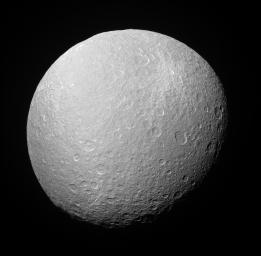
|
Above Rhea’s South Pole
- Click the image above for a larger view
- Full-Res JPEG (932 x 915) (80.0 kB)
- Full-Res TIFF (932 x 915) (853.9 kB)
Caption:
Cassini looks upward at the south polar region on Rhea during a recent distant encounter. Rhea's icy surface is so heavily saturated with impact craters that the moon's limb, or edge, has a rugged, bumpy appearance. Rhea is 1,528 kilometers (949 miles) across.
The bright splotch seen here near the upper right is impact material (or ejecta) from a relatively fresh crater (see PIA06648 for another view of this bright feature).
The image was taken with the Cassini spacecraft narrow-angle camera on July 14, 2005, at a distance of approximately 342,000 kilometers (212,000 miles) from Rhea and at a Sun-Rhea-spacecraft, or phase, angle of 36 degrees. The image was obtained using a filter sensitive to wavelengths of infrared light centered at 298 nanometers. The image scale is 2 kilometers (1 mile) per pixel.
Background Info:
The Cassini-Huygens mission is a cooperative project of NASA, the European Space Agency and the Italian Space Agency. The Jet Propulsion Laboratory, a division of the California Institute of Technology in Pasadena, manages the mission for NASA's Science Mission Directorate, Washington, D.C. The Cassini orbiter and its two onboard cameras were designed, developed and assembled at JPL. The imaging team is based at the Space Science Institute, Boulder, Colo.
For more information about the Cassini-Huygens mission visit http://saturn.jpl.nasa.gov . For additional images visit the Cassini imaging team homepage http://ciclops.org .
Cataloging Keywords:
| Name | Value | Additional Values |
|---|---|---|
| Target | Rhea | |
| System | Saturn | |
| Target Type | Satellite | |
| Mission | Cassini-Huygens | |
| Instrument Host | Cassini Orbiter | |
| Host Type | Orbiter | |
| Instrument | Imaging Science Subsystem (ISS) | |
| Detector | Narrow Angle Camera | |
| Extra Keywords | Crater, Grayscale, Impact, Infrared, Visual | |
| Acquisition Date | ||
| Release Date | 2005-08-25 | |
| Date in Caption | 2005-07-14 | |
| Image Credit | NASA/JPL/Space Science Institute | |
| Source | photojournal.jpl.nasa.gov/catalog/PIA07572 | |
| Identifier | PIA07572 | |
